India
The Road To Chopta
It will take almost 9 hours to get to Chopta, which I cannot even find on any map of India. It is somewhere around Gopeshwar, about 3/4 of the way to a journey to Badrinath. About a half hour out of Rishikesh and the view is beautiful, but still a long way from seeing any snow-capped peaks. The mountainside, which are at a slope of 65-70 degrees, are cut with terraced farms sometimes a thousand feet high, a truly impressive site. I can see right away that the Himalayan valley are incredibly narrow and steep, allowing for breathtaking views of the opposite sound of the canyon, which is tree lined or shrub lined all the way to the top - were not even close to the tree line in the Himalayas. I am reminded of the Asian mountain jungles in many movies. Of course this is Asia, and we're not that far from Burma/Myanamar, which technically is SouthEas Asia.
I see many women working in the fields and many walking along the roadside carrying huge bundles of hay or other greenery on their back, sometimes taking up part of the road. Numerous chai stands dot the roadside, as well as small towns, which Kuku drives through at a wicked speed, using the horn to get people out of harm's way. Some little towns have installed speed bumps/breakers, which is wise, methinks. Many roadside crews are made up of folks living in makeshift homes on the side of the road - tents made of plastic tarupulin, corrugated tin sheets held together by something, discarded wood. There are the ubiquitous cows, as well as dogs, that our driver Kuku has to contend with, along with jackassess (real ones, not human ones) and herds of goats. A thrill a minute on these roads, let me tell you.
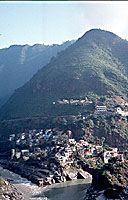 Our first stop after a great breakfast
(in what looks to me to be a new, clean
building - wow!) is the town of Devprayag.
Up to now we have been following the
canyon that holds the Ganges river. But
this ends at DevPrayag. Prayag loosely
means "confluence" the meeting of two
rivers or river and stream to form a
new, bigger river. Hindus believe it
is at these prayags, and there are several
along the way, where there is a great
natural and spiritual force, and these
places are so honored with temples and
such. But Deoprayag is the holiest of
all, because it is at this place where
two streams meet to form the Ganges -
this is the starting point of Gangaji,
and there is a temple on a small hill
right where the confluence occurs. We
stop and I get a few photos of my first
Himalayan town. The building of homes
on the hillsides in the Himalayas is
quite an art.
Our first stop after a great breakfast
(in what looks to me to be a new, clean
building - wow!) is the town of Devprayag.
Up to now we have been following the
canyon that holds the Ganges river. But
this ends at DevPrayag. Prayag loosely
means "confluence" the meeting of two
rivers or river and stream to form a
new, bigger river. Hindus believe it
is at these prayags, and there are several
along the way, where there is a great
natural and spiritual force, and these
places are so honored with temples and
such. But Deoprayag is the holiest of
all, because it is at this place where
two streams meet to form the Ganges -
this is the starting point of Gangaji,
and there is a temple on a small hill
right where the confluence occurs. We
stop and I get a few photos of my first
Himalayan town. The building of homes
on the hillsides in the Himalayas is
quite an art.
Afterwards, the mountainside gets higher and higher, the canyons steeper and steeper. At one point, Hari informs, me, we pass a river that it called Hell River, because it is in a canyon so narrow and steep, you cannot see it below and therefore, it must be in hell. The canyon reminds me of The Chasm of Eternal Doom from Python's Holy Grail, you know, what is your name? what is your mission? what is your favorite color? blue, no red aaaaaagh!
With Hari and Sumet, a couple of 19 year olders and Kuku not much older, the subject quickly turns to sex, drugs and rock and roll. Hari is the taxi DJ, and I get delivered a healthy dose of Hindu Rock and Roll, which has a nice mix of traditional and rock and roll, a little rockier than Jai Uttal, but I like it. At the end of the trip, I know the entire soundtrack to Hero of Hindustani, a movie out of Bollywood, which is Bombay, India's Hollywood, which produces more films than Hollywood, and most apparent are real shlock.
Sumet, being 19, is very interested in hearing about my sex life before I was married, when I was going out with the loose, slutty American women. I told him, yes, I did have sex with my girlfriends, but I didn't want to provide too many details as not to torture the poor fellow. He tells me that one cannot get even to first base in most cases, Indian women do not give it away till after the marriage ceremony. Even the discos in most places are for couples only, no meat markets in this place. I can feel his frustration.
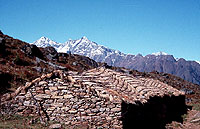 In fact, I cannot remember even seeing
any outward display of affection between
the sexes. But Indian men show much
physical affection in public - I've
seen men having arms around shoulders,
holding arms and even holding hands,
quite permissable and non-sexual. Of
course I also am used to it, being
from the San Francisco area, but that's
a whole other scene. I see Hari shows
much pure love and affection for Sumet,
which is very sweet and innocent. Even
their girl watching seemed a bit tame,
though I've seen some real assholes
in the streets of Delhi - it's called
Eve Teasing and it really is bullshit.
But Sumet and Hari, like most testosterone
saturated 19 year old guys, have to find
outlets for it, for Hari, it's sports,
for Sumet, apparently it's partying.
Thankfully it's not channelled into
violence and war too much in India.
Sumet asks me what I think of Indian
women, and I tell him that I think they're
beautiful, the great skin tone, and
saris seem to be a great blend of
sexiness and modesty. After all it is
a skirt and a tight halter top, but
slightly hidden by a shawl. And the
women who are wealthy enough to
own make-up do it well. Except for
the little girls and beggars, the
women are very shy, and Sumet informs
me that for the most part it's
a master-servant relationship in
Indian marriages. I don't know if
he is right or not, but I do tell
him that the divorce rate in the US
is about 50%, so neither culture
can be too arrogant.
In fact, I cannot remember even seeing
any outward display of affection between
the sexes. But Indian men show much
physical affection in public - I've
seen men having arms around shoulders,
holding arms and even holding hands,
quite permissable and non-sexual. Of
course I also am used to it, being
from the San Francisco area, but that's
a whole other scene. I see Hari shows
much pure love and affection for Sumet,
which is very sweet and innocent. Even
their girl watching seemed a bit tame,
though I've seen some real assholes
in the streets of Delhi - it's called
Eve Teasing and it really is bullshit.
But Sumet and Hari, like most testosterone
saturated 19 year old guys, have to find
outlets for it, for Hari, it's sports,
for Sumet, apparently it's partying.
Thankfully it's not channelled into
violence and war too much in India.
Sumet asks me what I think of Indian
women, and I tell him that I think they're
beautiful, the great skin tone, and
saris seem to be a great blend of
sexiness and modesty. After all it is
a skirt and a tight halter top, but
slightly hidden by a shawl. And the
women who are wealthy enough to
own make-up do it well. Except for
the little girls and beggars, the
women are very shy, and Sumet informs
me that for the most part it's
a master-servant relationship in
Indian marriages. I don't know if
he is right or not, but I do tell
him that the divorce rate in the US
is about 50%, so neither culture
can be too arrogant.
Around the town of Srinigar, a landslide created a casualty - a truck gets caught in the dirt, and blocks the entire road. So we're stuck for awhile. Now in the Uttar Pradesh mountains, you don't call for the tow truck, there aren't any. So whomever can pitch in a hand does. But in the meantime, traffic is backed up both going up and downhill. Kuku deftly steers us to the nearest chai stand. While we are waiting I go to use the great outdoors bathroom, hoping that a cobra doesn't bite me in the butt while I'm squatting. I follow a small path near a stream and pass two water buffalo, the first time I've seen ones close up and live. Man, what massive creatures, and dumb, they make cows look like geniuses. Perhaps bad cows get reincarnated as water buffalos. I really like the cows in India, and some of them develop real street-smarts.
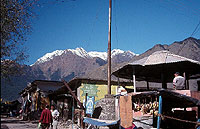 After an hour's wait there is just enough
room to get past the stuck truck, so
someone or divine grace creates an orderly
flow of convoys going in both directions.
Like a lot of things in India, things
just work out from the chaos and this is
no exception. And we're on our way. Kuku,
like all taxi drivers, must make the
mandatory passing of all the trucks and
busses in our convoy, along sharp, curvey
roads. It's like a written rule - if you're
a taxi, you must pass by any bigger vehicle.
Which I don't mind because spending the
rest of a trip inhaling the noxious
exhaust of a truck or bus in front of
us is not my idea of a good time.
After an hour's wait there is just enough
room to get past the stuck truck, so
someone or divine grace creates an orderly
flow of convoys going in both directions.
Like a lot of things in India, things
just work out from the chaos and this is
no exception. And we're on our way. Kuku,
like all taxi drivers, must make the
mandatory passing of all the trucks and
busses in our convoy, along sharp, curvey
roads. It's like a written rule - if you're
a taxi, you must pass by any bigger vehicle.
Which I don't mind because spending the
rest of a trip inhaling the noxious
exhaust of a truck or bus in front of
us is not my idea of a good time.
With every passing hour, we climb to higher elevations and the canyon views are incredible. It's hard to describe, and unfortunately it is hard to photograph, as the road is too bumpy to snap a picture, and there are few places to stop. But when we do stop, I do my Ansel Adams wannabe number. I notice that the people are darker and if I didn't know that I was in the Himalayas, I could swear it was the Andes. The facial features and the dress looked very Andean-like. Some women have major nose ring action, not huge loops but pretty impressive nonetheless.
Chopta and Tsungnath
Due to the roadblock, we arrive in Chopta (or Chopata), which is not exactly a big town, more like a truck stop. This town has one purpose, to serve the pilgrims coming to the Tungnath Shiva temple, 3km up the hill above town.
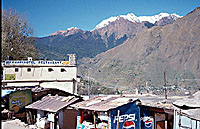 At this point I've gotten my first
views of the snow capped Himalayas, and
it is impressive. I never realized how
steep the mountains are, thin slivers
of rock up to 25000 feet high, cut below
by rivers over thousands of years. It's
amazing that there is a road through
here and that there are numerous towns
dotting the Himalayas on such steep
slopes. You could walk outside your
porch and fall 8000 feet, I'm not
joking. And Kuku could make one mistake
and we can fall the same 8000 feet.
At this point I've gotten my first
views of the snow capped Himalayas, and
it is impressive. I never realized how
steep the mountains are, thin slivers
of rock up to 25000 feet high, cut below
by rivers over thousands of years. It's
amazing that there is a road through
here and that there are numerous towns
dotting the Himalayas on such steep
slopes. You could walk outside your
porch and fall 8000 feet, I'm not
joking. And Kuku could make one mistake
and we can fall the same 8000 feet.
We stop to take lunch in Chopta, and of course, I'm the event, the white guy in India. Sumet and Hari help me to order some food, and I'm really into bhujia and alu paranthas, scrambled eggs and potato bread. Of course, chai with every meal, but this is real chai, with the cardamon and ginger, instead of super-sweet english tea. Hopefully I have enough Kyolic to offset the cholestorol parade.
Now Chopta is at 9000 feet, and I can feel the thinness of the air. And I am about to take a walk uphill for 3 kilometers to the Tungnath temple and beyond, and this concerns me. Annie and I have done this in California - go from sea level to the east side of Yosemite National park at 10,000 feet and take a hike and wonder why our bodies are going into shock.
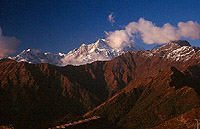 And after taking off on our journey,
the same starts happening to
me. For the first half, I am fine, and am
enjoying an incredible 180 degree
view of the Himalayan range. But step
after step along the path becomes
increasingly difficult - I am closing
in on 10,000 feet and being old enough
to be Hari's and Sumet's father, I
have to stop with more frequency to
catch my my breath. About 2/3 of
the way, I am starting to feel faint,
and having difficulty in catching
my breath. Then my body would seem
to adjust for awhile, I would get
a second wind, and then I would feel
faint again. Meanwhile, the approaching
sunset was creating world-class
"alpenglow" photographic possibilities.
But at times, even picking up my
camera would cause me to lose my
breath. Prior to the start of this
little trek, Sumet informs me that
the Tungnath temple is closed, which
is disappointing, but it is still worth
it to go to the temple grounds.
And after taking off on our journey,
the same starts happening to
me. For the first half, I am fine, and am
enjoying an incredible 180 degree
view of the Himalayan range. But step
after step along the path becomes
increasingly difficult - I am closing
in on 10,000 feet and being old enough
to be Hari's and Sumet's father, I
have to stop with more frequency to
catch my my breath. About 2/3 of
the way, I am starting to feel faint,
and having difficulty in catching
my breath. Then my body would seem
to adjust for awhile, I would get
a second wind, and then I would feel
faint again. Meanwhile, the approaching
sunset was creating world-class
"alpenglow" photographic possibilities.
But at times, even picking up my
camera would cause me to lose my
breath. Prior to the start of this
little trek, Sumet informs me that
the Tungnath temple is closed, which
is disappointing, but it is still worth
it to go to the temple grounds.
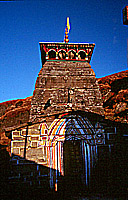 Using all the male ego I can possibly
muster, I move on and now the temple
is in sight, a small structure similar
to the structure in Yamunotri, which
requires a much more arduous trek.
Using all the male ego I can possibly
muster, I move on and now the temple
is in sight, a small structure similar
to the structure in Yamunotri, which
requires a much more arduous trek.
I am one hurtin' unit, but I make it to the temple grounds an peek inside the temple. Despite the shock to my body, I can feel a wave of deep equanimity come over my body, which I am thankful for, some reminder as to why I made this 3km trek at 10,000 feet. Hari is getting a bit worried 'cause the sunset is getting on mighty quickly and it is going to be mighty cold mighty quickly.
Getting down I thought would be easier, but it was just as painful. Despite the pain, the view was so, so magnificent, and I burned through a roll or two of film. The path to the temple is very well constructed, shale rock planted sideways to give good footing, but nevertheless at times I'm like a drunken sailor, stumbling here and there. It seemed like an eternity to get off that mountain, and by the end of the little trek, we were using moonlight to find our way down the path. Needless to say I was relieved to see Kuku and his cab. We got in and Kuku hauled ass in the dark through some really treacherous roads to get to Gopeshwar, where we were to spend the night. As bad as the altitude shock to my system, it was nothing compared to the sanitary shock I was to receive in Gopeshwar.
 Back |
 Himalayas, con't. |
|
|
Page 12. |
||
